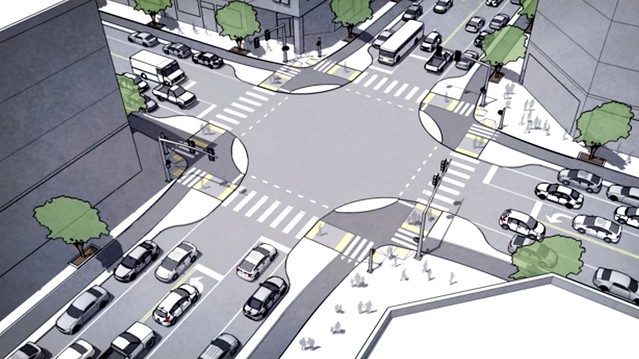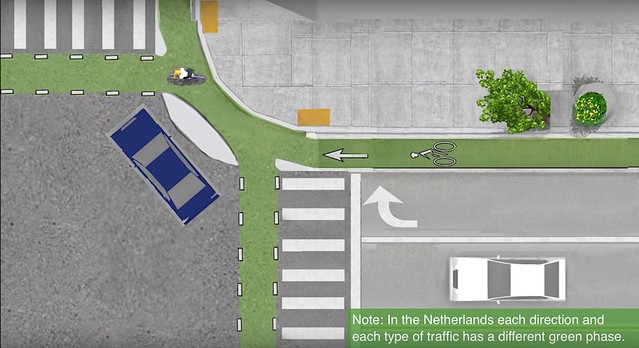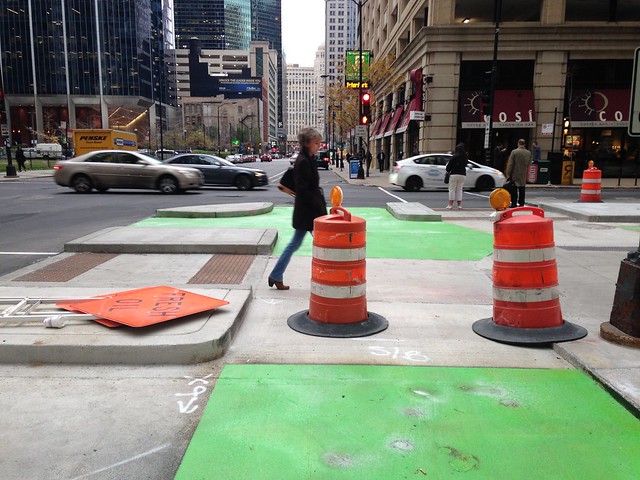As part of the Loop Link bus rapid transit project, which includes the construction of protected bike lanes on Washington, Randolph, and Clinton downtown, the Chicago Department of Transportation is trying a kind of intersection treatment that’s new to our city. Inspired by Dutch-style “protected intersections,” they’re installing special concrete curbs and islands in an effort to shield cyclists from turning vehicles.
The Clinton two-way lane was completed several weeks ago, and the Washington protected lane, which is separated from moving cars by the BRT system’s island bus stations, as well as concrete curbs and flexible plastic posts, is largely finished. CDOT hasn’t yet begun work on the Randolph PBL, pending the completion of a construction project at Block 37, but most of the separation will come from posts, not concrete, according to spokesman Mike Claffey.
The department recently completed the new intersection treatment at the southeast corner of Washington/Franklin. A similar approach is planned for Washington/Dearborn, Randolph/Dearborn, Randolph/Franklin, and Randolph/Canal. “Our goal is to provide separation up to the intersection to minimize conflicts between bikes and cars.” Claffey said. “We’ll monitor them to see how effective they are.”

Before we take a look at Washington/Franklin, here’s some background on how protected intersections function. These designs use curbs, islands, pavement markings, and bicycle-friendly traffic signals to ensure that the safety offered by protected bike lanes isn’t lost when a cyclist gets to a cross street.
A key aspect of protected intersections is the creation of proper sight lines between drivers and bicyclists. Motorists who are turning right are positioned at a 90-degree angle to the bike lane with enough time to see bicyclists riding straight through the intersection and hit the brakes if necessary. This prevents “right hook” crashes.

Protected intersections have been common in the Netherlands for quite a while. Recently, the concept has become more familiar to U.S. bike planners and advocates, partly thanks to some useful videos explaining how the intersections work. Several years ago, Mark Waagenbuur from Den Bosch, Netherlands, author of the Bicycle Dutch blog, published this video, which shows that many typical American street intersections have sufficient space to be modified into protected intersections.
The idea became more widespread in 2014, when Portland-based urban planner Nick Falbo, created a website about protected intersections, featuring studio-quality animation. Since then, two Dutch-inspired protected intersections have been built in Davis, California, and Salt Lake City.
Steven Vance has done more research about protected intersections than I have, so I’ll let him provide his initial impressions of the new installation:
From what I can see from the placement and design of the curb and concrete islands at Washington and Franklin, the intersection doesn’t meet the design standards of a Dutch-style protected intersection because it doesn’t provide the setback bike lane, making space for a right-turning motorist to see a bicyclist with the correct, nearly right-angle sightline, nor does it provide a good amount of space for queuing bicyclists.
To build it in the way shown in Waagenbuur’s animation, the main change would be rounding the curbs and concrete islands CDOT already built, and setting back the stop bars and crosswalk markings on Franklin.
While the new treatment may not be a full-fledged protected intersection, my impression is that it will do some good for preventing right-hooks. Moreover, CDOT deserves credit for trying something new. Hopefully they’ll pilot a straight-up Dutch-style intersection at another location in the near future.
To give you an idea of how the Loop treatment functions, here are a couple of clips I took while riding east and north via the facility.




